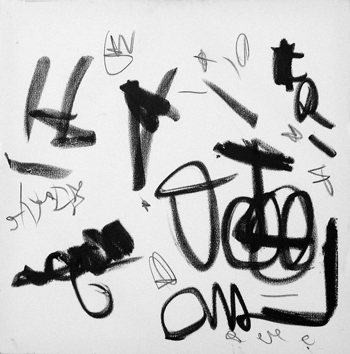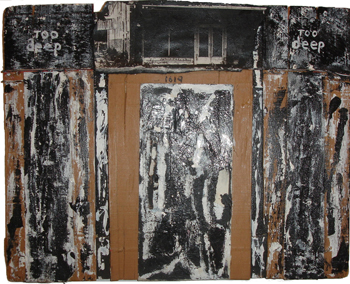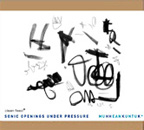 |
randee
silv: painting 736 - oil on canvas 30x30
in.
Front Cover Art
|
 |
| Patrick-Earl:Too
Deep - paintied for insert, but not included
due to technical problems at Clean Feed |
|
sonic
openings under pressure
MUHHEANKUNTUK
river that
flows two ways
Clean Feed
CF081
patrick
brennan
compositions, saxophone
David Pleasant
densemetriX! (percussion, harmonica,
voice)
Hilliard Greene
bass viol
1.
tilting curvaceous
2. abundant
3. flash of the spirit
4. The Hardships (Pleasant)
5. prosified
6. the terrible 3s
7. permeations gumvindaboloo
Recorded
June 2006
ParkWestStudios
Brooklyn, NY
|
Liner
Notes by Rui Horta Santos:
To
simply associate patrick brennan’s music to the
free jazz movement would be like reducing Arnold Schoenberg’s
work to mere free atonality, thus neglecting the composer’s
major contribution to western music: his twelve-tone composition
technique. The comparison may seem far-fetched but it
is not, as both musicians have searched for an intrinsic
compromise between freedom and form. In Schoenberg’s
case the issue initially addressed was the antagonism
between tonality and melodic invention. With brennan the
concern begins with rhythmic and tonal structures but
ends with the same obsession: formal coherence. Consequently,
his original sense of structure both sets and enhances
the atmosphere for the subsequent improvised musical drama.
The resulting tension may mislead a less attentive listener.
On the one hand there is a profound sense of tradition;
on the other hand there is the will to defy those same
limits. But what brings this music unquestionably alive
is the strife between these apparently antagonistic forces.
What
also reveals patrick brennan’s exquisite sense of
musicianship is his careful crafting of polyrhythmic grooves
as much as his more-than-adequate choice of musical collaborators.
Both aspects go hand in hand. Thus it is not by accident
that he should choose so sharp a focal point as Hilliard
Greene or the intricate rhythmic harmonies emerging out
of ensemble co-composer David Pleasant's Densemetrix!
conception.
There
are quite a few good reasons why a CD by patrick brennan
should have such a name as ‘muhheankuntuck’.
The idea of a river flowing in both directions, which
is what the title means, gives a good hint as to how the
composer, alto player and band leader, relates to the
cultural environment in which he is submerged. Muhheankuntuck
was the original name given to the Hudson River by the
New York City area indigenous Lenape tribe.
In
the first place, although patrick brennan is extremely
concerned with breaking into new musical territories (the
river’s continuous forward flow), his work is constantly
informed by the tradition that lies behind him (the recurring
backwash produced by the incoming tide). Although that
can be said of a vast spectrum of musicians, in patrick
brennan’s case the latitude of his search is indeed
far-reaching. It starts with the trance-inducing aspects
of traditional African music and ends with the musician’s
very personal metamorphosis of those qualities into something
quite new and which he denominates as ‘metagrooves’.
In between those two poles lies his interest in the vast
heritage of African-American music. As David Pleasant
has put it, "Africans gave us a way to see the multi-layered
authenticity of human experience through polyrhythm and
syncopation. That gift allows us to realize a daily connection
to the essential motion of all things."
Secondly,
recording for Clean Feed Records is a ‘slight return’
within his own personal history. Having lived and performed
extensively throughout Portugal in the early and mid 90’s,
he paid too many dues in a country that was basically
not yet ready for his forward vision. Fortunately things
have radically changed, for the better. patrick brennan’s
presence on a Portuguese label confirms the lasting impression
he has left behind, at least in the eyes of a significant
few. Curiously enough, the first time he heard Hilliard
Greene and David Pleasant play was while he was still
residing in Lisbon, through Charles Gayle’s record
‘Repent’. So it seems like the loose ends
of his European phase have finally locked into place.
If
at the end of the day any ambiguity remains as to which
way the river really flows, the music leaves no doubt
as to where it is really heading: FORWARD!
Lisbon,
1 April 2007
Rui
Horta Santos
TOP
patrick
brennan on the music of sonic
openings under pressure:
This
is music composed specifically to unfold through collective
improvisation, which means that the form of the music
itself is directly shaped through mutual interplay among
its participants, and that collaborative drama contributes
centrally to the musical narrative a listener hears.
This
approach to coordinating music poses a deliberate alternative
to the relative one way flow of information that passes
between composer & performer in much euroclassical
practice as well as to that genre’s orientation
toward the construction of sonic monuments, a propensity
also shared by much pop music. Pop formulations furthermore
have tended to compress rhythmic scope down to basic denominator
background beats. And, while much contemporary improvised
music may emulate open form as developed through jazz,
the root African elements & attitudes out of which
this evolved have many times been distilled out.
Collective
improvisation can also be recognized as a theatrical personification
of the dynamics of polyrhythm - that intricately sophisticated
African model of coordinated multiplicity. Polyphonically
organized music is able to integrate divergent voices,
levels, directions & narratives; but the wave matrix
of polyrhythm’s gravitational convergences &
suspensions further enriches each moment of music with
a holographic sensation of depth. This especially charges
& activates the gaps & silences that envelop musical
gestures & encourages attention beyond linear &
sequential interpretations of activity to include more
multidimensional perceptions of time & movement.
This
music often explores making polyrhythm central to the
organization & participation of the entire ensemble.
One strategy has been to code polyrhythm into the music
via a stacking of interrelated countermelodies that places
each instrumentalist in a position of direct responsibility
for the composite ensemble sound. The countermelodies
- & the relationships among them - provide a thematic
interface that supports both extemporized development
& communications among improvisers as the music progresses.
MetagrooveÔ is an allied compositional process that
associates successive, contrasting polyrhythmic constellations
(i.e. grooves) to create a overall groovic resonance (in
other words, a meta- groove).
Each
voice in this ensemble maintains an equal distinct narrative
foreground persona; & it follows that much of the
compositional focus has been on developing music through
the rhythm section. As Bakongo scholar Fu-Kiau Bunseki
has put it, “Treble voicings represent our world,
but bass patterns come from the spirit.” The bass
not only carries on an independent melodic narrative at
a pace appropriate to its register, but often functions
as conductor of the ensemble, cueing shifts from one metagrooveÔ
constellation to the next. These shifts are also multidirectionally
jointed, allowing an overall form to wrap around itself
& construct an ensemble narrative that’s more
oriented toward immersion than linear progression from
beginning to end.
It’s
also natural that drums figure prominently in a music
that explores rhythmic harmony & multidirectional
movement. Some listeners may at first be disoriented by
percussion’s abundant role here. But, as a trap
kit enables the playing of as many as four simultaneous
lines, it can also be considered as contributing more
than one instrument to the ensemble. The non-tempered
tones enunciated by drums contribute a significant component
of this music’s melodic & tonal framework. Even
a casual listening to Dou Dou Njaye Rose’s orchestra
of sabar wolofs from Dakar, for example, can reinforce
a recognition that drums, all by themselves, have more
than enough range to enact complete & nuanced statements
on as high a level as any music.
Some
market oriented & cultural perspectives argue that
music shouldn’t overly stretch or challenge listeners’
imaginations. Contrarily, this music aims toward a threshold
where some aspect is slipping just enough beyond a listener’s
comprehension to invite a sense of wonder & mystery
as a small reminder that there’s always something
more happening anywhere than is already known & recognized.
-
patrick brennan
TOP
